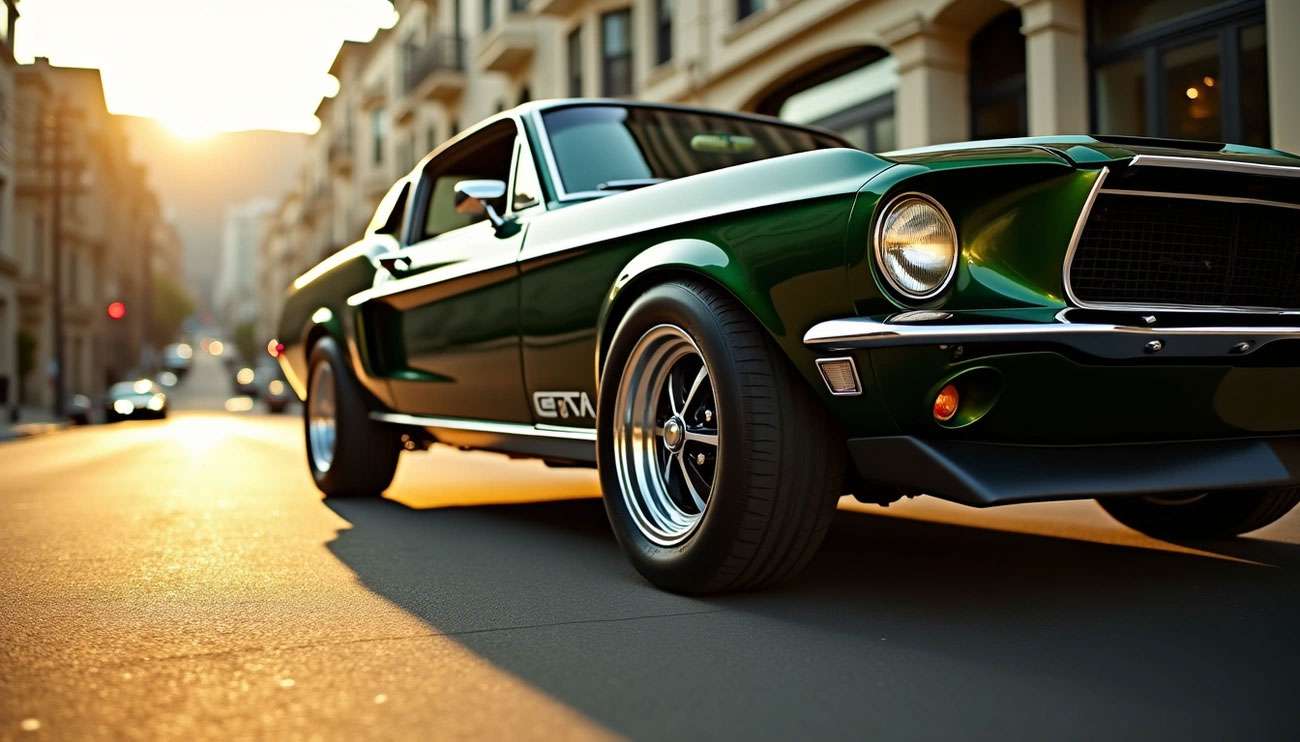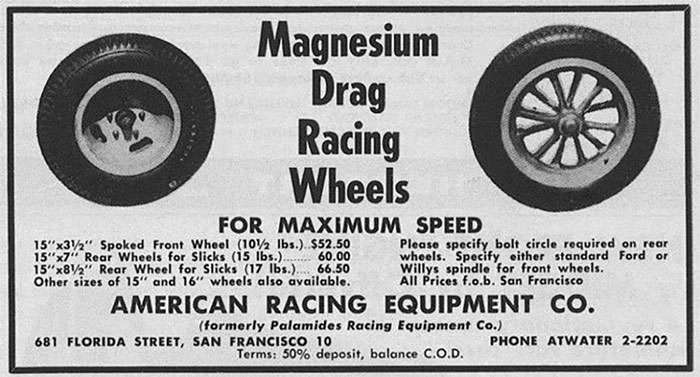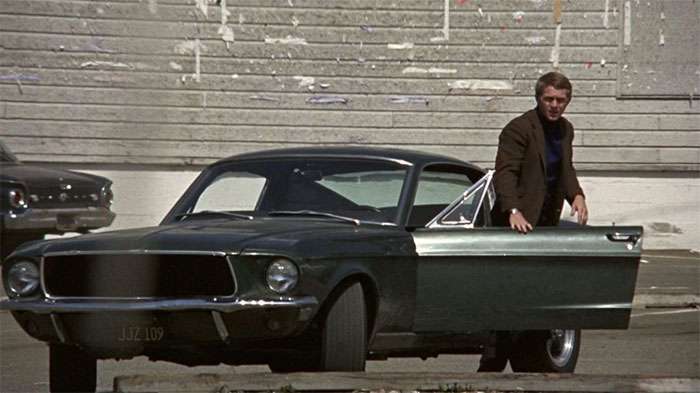
American Racing wheels changed automotive history with one revolutionary design: the Torq Thrust. This iconic five-spoke wheel appears on more hot rods and muscle cars than any other wheel design ever created. The Torq Thrust's distinctive profile has defined American performance style for over six decades, outlasting countless competitors and imitators.
Those five distinctive spokes that flare outward as they meet the rim create the unmistakable look of classic American Racing wheels. The Torq Thrust delivered far more than striking appearance—its five tapered, parabolic contour spokes reduced overall wheel weight while improving brake cooling performance. American Racing has operated continuously from California since 1956, making it the longest continuously operating aftermarket wheel maker in the United States.
The company's influence extends well beyond racetracks into Hollywood stardom. Steve McQueen chose American Racing Torq Thrusts for his Highland Green Mustang in the legendary 1968 film "Bullitt", creating an automotive icon that still inspires enthusiasts today. The Torq Thrust had already dominated hot rodding culture by the time "Bullitt" hit theaters, proving that great design transcends any single application or era.

Image Source: Hemmings
American Racing Wheels emerged from a simple problem that plagued drag racers across California. Romeo Palamides, a chassis builder and drag racing innovator, partnered with Jim Ellison, a San Francisco machine shop owner, to solve what seemed impossible at the time.
Palamides and Ellison began their partnership in 1954, initially building a fuel dragster together. Operating under the name Palamides Automotive, they crafted specialized wheels that immediately caught attention in racing circles. The company was officially incorporated as American Racing Equipment in 1956, though they had been producing wheels since their 1954 collaboration.
Engineer Tom Griffith joined their efforts, working from Ellison's small machine shop to develop what would become revolutionary wheel designs. This three-man team would change American racing forever.
Drag racers in the mid-1950s faced a frustrating dilemma. They desperately needed wheels that delivered both lightweight performance and uncompromising durability. Heavy steel wheels (steelies) dominated the tracks, but their weight severely compromised acceleration and overall performance.
Racing alternatives offered little hope. Stock OEM wheels couldn't handle the stress of serious racing, while semi-solid wheels cost more than most racers could afford. The market gap was clear—racers needed wheels with "an enviable strength-to-weight ratio" that wouldn't empty their wallets.
Palamides understood this challenge intimately. His experience building customs and race cars taught him that every pound of rotating weight mattered. Lighter wheels could transform a car's performance, but finding the right solution required innovation.
The breakthrough came when Palamides and Ellison decided to experiment with magnesium, the lightest structural metal available. Magnesium is approximately 1.5 times less dense than aluminum, offering significant weight savings while maintaining the strength racing demanded.
Their innovative magnesium wheels made their debut on a purpose-built dragster featured on the November 1956 cover of Hot Rod Magazine. The dragster was impressive, but those distinctive wheels stole the show. Orders flooded in after the magazine hit newsstands, officially launching American Racing Wheels as a business.
These early magnesium wheels weren't perfect. Corrosion presented ongoing challenges, gradually damaging wheel surfaces over time. The industry eventually developed improved chemical treatments to address this issue, but the initial breakthrough had already changed everything.
"By using then-current techniques for casting magnesium, A.R.E. was able to create wheels for drag race cars that were lighter, and in some cases, stronger than what serious drag racers had been using to that point." — Terry McGean, Editor, Hemmings Motor News (veteran automotive journalist and historian)
American Racing's decision to experiment with magnesium created a revolution in wheel technology. This lightweight metal solved the fundamental problem drag racers faced—getting maximum strength with minimum weight.
Magnesium delivered exactly what racers needed most. As the lightest structural metal available, magnesium weighs approximately 1.5 times less than aluminum and 4.5 times less than steel. These wheels maintained comparable strength while dramatically reducing weight, giving racers the performance edge they sought.
The performance improvements were immediate and measurable. Reducing unsprung weight enhanced acceleration response, improved braking performance, and delivered sharper handling characteristics. Magnesium wheels could even improve fuel efficiency by up to 8% in urban driving conditions.
Magnesium offered another crucial advantage—superior vibration dampening capabilities. The metal absorbs and dissipates shocks up to 50 times more effectively than aluminum. This reduced vibration load on critical vehicle components including the engine, suspension, and transmission, extending their service life.
Magnesium wheels weren't perfect solutions. Magnesium alloys proved highly susceptible to corrosion, requiring special anti-corrosion coatings to maintain structural integrity. The flammability of magnesium created serious safety concerns—certain UK motorsports banned magnesium wheels entirely.
The specialized manufacturing process made these wheels expensive to produce, limiting their appeal to professional racers and high-end applications. Most enthusiasts couldn't justify the cost despite the performance benefits.
American Racing recognized these limitations and developed aluminum versions of their wheels. The December 1959 issue of Hot Rod magazine advertised the original magnesium drag racing wheels at $88 each—nearly $100 in today's money. The aluminum alternatives offered much better value at $49 each.
Aluminum wheels weighed about 25% more than their magnesium counterparts but cost significantly less and resisted corrosion much better. This made American Racing wheels accessible to a broader market beyond professional racers.
Even after the material change, the term "mag wheel" remained as the standard description for any cast performance wheel. American Racing had permanently influenced automotive terminology, proving their impact extended far beyond just making better wheels.

Image Source: Threepieceus
The Torq Thrust debuted in 1963 and quickly became the most recognizable aftermarket wheel ever created. What started as "magnesium drag racing wheels" advertised in the December 1959 issue of Hot Rod magazine would reshape automotive culture within just a few years.
The Torq Thrust delivered exceptional strength while reducing weight through its engineering. The open spoke design allowed superior brake cooling, addressing a critical need for racers pushing their vehicles to the limit. This wasn't just about looks—the wheel solved real performance problems.
Hot Rod Magazine recognized the Torq Thrust as "one of the top 20 speed parts that changed the world". The original magnesium versions commanded $88 each in 1959, nearly $100 in today's money.
Torq Thrust wheels appeared on streets by 1962, with hot rods and customs sporting American mags at the 1962 Grand National Roadster Show. American Racing introduced a more affordable aluminum version in 1965 at $49 each, including lug nuts and hub cover. Find your next set of American Racing Wheels here to join this long tradition of automotive excellence.
American Racing created the Torq Thrust D with convex-curved spokes to accommodate disk brake calipers without spacers. The Torq Thrust II followed around 1967, featuring two-piece construction with cast aluminum centers welded to forged aluminum outer barrels. This innovation allowed custom widths and backspacings—essential for modified vehicles.
The Torq Thrust's success triggered immediate imitation. The same 1965 Hot Rod issue that announced aluminum Torq Thrusts featured competitor Ansen advertising a knockoff design. The wheel spawned countless copies from manufacturers like Appliance, Fenton, and Astro. American Racing remained the original that others tried to copy.
"The iconic five-spoke wheel has been found on more hot rods and muscle cars than any other wheel. It is the wheel most emulated, pirated and blatantly ripped-off. It's the hot rod wheel." — Andrew Wolf, Editor, Dragzine (specialist in drag racing history and technology)

Image Source: Hagerty UK
American Racing wheels found their way from drag strips to movie sets, creating automotive icons that shaped car culture across generations. Hollywood discovered what racers already knew—these wheels delivered both performance and unmistakable style.
Steve McQueen changed everything when he personally chose Torq Thrust wheels for his Highland Green Mustang GT 390 fastback in the 1968 film "Bullitt". McQueen crafted the Mustang's distinctive look by removing emblems, blacking out the grille, and most importantly, selecting those iconic five-spoke American Racing wheels. The result created what many consider the most memorable chase scene in cinema history.
The wheels appeared on countless legendary screen vehicles that defined automotive culture. The General Lee Dodge Charger from "Dukes of Hazard" showcased their aggressive styling. "Two-Lane Blacktop" featured them prominently, and "American Graffiti" put them on cars driven by the teenage protagonists. The A-Team's 1983 GMC Vandura sported red American Racing Vector wheels, while the Fast & Furious franchise continued this Hollywood tradition.
These film appearances influenced entire generations of automotive enthusiasts. According to Jody Groce, president at American Racing, "It's hard to imagine that these wheels were featured on what is arguably the best chase scene in American cinema as well as iconic motorsports moments that many of our customers grew up watching as kids". This media exposure established American Racing wheels as the definitive choice for authentic American performance style.
American Racing wheels have shaped automotive culture for over six decades, starting with Romeo Palamides and Jim Ellison's drag racing innovation and evolving into the most copied wheel design in history. The Torq Thrust's distinctive five-spoke pattern continues to define authentic American performance style, whether you're building a classic hot rod or upgrading a modern vehicle.
The company's smart transition from magnesium to aluminum made revolutionary wheel designs available to everyday enthusiasts without sacrificing the performance advantages that built their reputation. From dragstrips to Hollywood movie sets, these wheels earned their place in automotive history through proven performance and unmistakable style.
As the longest continuously operating aftermarket wheel maker in the United States, American Racing maintains its leadership by delivering what enthusiasts demand—wheels that combine superior performance, distinctive appearance, and genuine heritage. Find your next set of American Racing Wheels at https://www.performanceplustire.com/American_Racing_Wheels and join this legendary automotive tradition.
Whether you're restoring a vintage muscle car or customizing a contemporary performance vehicle, American Racing wheels offer the same winning combination of strength, style, and authenticity that has defined American automotive excellence for generations. That's why these wheels remain as popular today as they were when they first appeared on dragstrips over sixty years ago.
American Racing Wheels transformed from a 1950s drag racing solution into an automotive icon that shaped car culture for over six decades.
• American Racing pioneered lightweight magnesium wheels in 1956, solving drag racers' need for strong yet light wheels that improved performance significantly.
• The iconic Torq Thrust's five-spoke design became the most copied wheel in history, featuring superior brake cooling and distinctive flared spokes.
• Hollywood cemented their cultural status when Steve McQueen chose Torq Thrust wheels for his Mustang in "Bullitt," creating cinema's most memorable chase scene.
• The company strategically transitioned from expensive magnesium to affordable aluminum wheels, making performance styling accessible to everyday enthusiasts while maintaining their racing heritage.
American Racing remains the longest continuously operating aftermarket wheel maker in the United States, proving that innovative design combined with authentic performance heritage creates lasting automotive influence that transcends generations.
American Racing Wheels was founded in 1956 by Romeo Palamides, a drag racing innovator, along with Jim Ellison. They started the company to address the need for lightweight, durable wheels in drag racing.
The Torq Thrust's distinctive five-spoke design, which flares outward like bell-bottoms, offered exceptional strength while reducing weight. Its open design allowed for superior brake cooling, making it ideal for both racing and street use.
Initially using magnesium for racing wheels, American Racing later introduced more affordable and practical aluminum versions for street use. This shift made their revolutionary designs accessible to average enthusiasts while maintaining performance benefits.
Hollywood significantly boosted American Racing Wheels' popularity, particularly when Steve McQueen chose Torq Thrust wheels for his Mustang in the 1968 film "Bullitt." This appearance, along with others in popular movies and TV shows, cemented the wheels' status in popular culture.
Authentic vintage American Racing wheels can be identified by looking for the classic "American Racing Equipment" stamping on the inside of the wheel. This marking is a hallmark of genuine American Racing products from their earlier years.